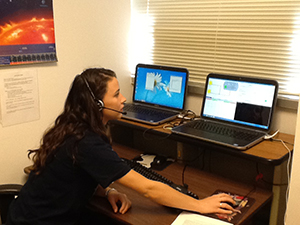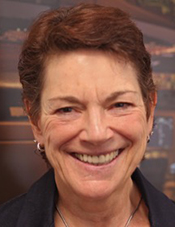Researchers develop NASA protocols for time-delay challenges
Astronauts on board the Pioneer, a spacecraft heading home from Mars, are categorizing asteroid samples when their life-support system suddenly malfunctions. The only person who can help is the NASA engineer with the information they need to get the system up and running. But in deep space, communication is delayed -- each message takes five minutes to transmit, followed by another five minutes to get a response. Their communications grow panicked, responses get confused, and the minutes between each message seem to drag on.

Lab assistant Laura King participated in research that is being used to develop communication protocols for NASA missions into deep space.
In reality, the astronaut and engineer are less than 10 feet apart. They are San Francisco State University students engaged in a simulation exercise, holed up in side-by-side, closet-size offices pretending to be millions of miles apart.
Lessons learned from these students' experiences will be used to improve communication among actual NASA astronauts on deep-space missions -- such as circumnavigating Mars, where the delay is expected to stretch up to 20 minutes each way.
"We're assessing the impact of the time delay on performance effectiveness and developing protocols and procedures that astronauts will eventually use to counteract the negative effects," explained Professor of Psychology Kathleen Mosier, who is leading the NASA-funded research at SF State.
Mosier and her team, who have been conducting this research for three years in collaboration with a team led by Ute Fischer at the Georgia Institute of Technology, have developed several time-delay communication protocols, which are now being implemented in NASA simulations.
To develop these best practices, students first participated in two 90-minute simulations, once with a delay and once without, to understand the particular communication challenges caused by the delay. While exchanging voice and text messages about the system failure, the teams also had to perform basic tasks, such as sorting and cataloging "asteroid samples" and recording system parameters every five minutes.

Professor of Psychology Kathleen Mosier
"The idea was to create a cognitively challenging situation," Mosier explained. "Then we studied how well they were able to complete the tasks and how many communications they ended up using. We looked at the crews that did well and tried to understand what they did."
Based on their analysis, the team developed protocols, then tested them by sending some students back aboard the "Pioneer" with instructions to follow these protocols and others with no guidance. As the final step of the research, results of this last round of simulations are being analyzed to quantify the protocols' effectiveness.
One of the biggest challenges Mosier's team experienced was that participants lost track of conversation threads, resulting in confusion.
"You send a message about something and before you get the response, you send a message about something else," Mosier said. "Then finally you get a response and you aren't sure whether it's a response to the first message or the second message."
To combat this problem, Mosier and Fischer recommended labeling threads of communication to keep them clear.
Problems also resulted when participants failed to note the time they sent a message, leading to stress and inefficiency.
"They would send the message and know it takes 10 minutes to get a response, but they wouldn't track the time they sent it," Mosier said. "So after about six minutes, they feel like it's been a long time, maybe it wasn't received, let me send it again. That creates even more confusion."
Mosier and Fischer suggested documenting the time each message is sent and the earliest time a response can be expected, a protocol NASA has already begun to adopt in its simulations through an automated text-based system.
The team also recommended making each transmission as effective as possible by compiling all relevant information into one message to avoid the need to answer follow-up questions, which would waste time with more 10-minute delays.
Mosier, an organizational psychologist who worked at the NASA Ames Research Center for seven years prior to coming to SF State, said this project appeals to her interests in teamwork, communication and decision-making.
Mosier's students have also been excited to participate, she said. Even if they don't actually get to travel to Mars, their research, in a sense, will.
"Most students don't get the opportunity to do research that has such immediate applications," Mosier said.